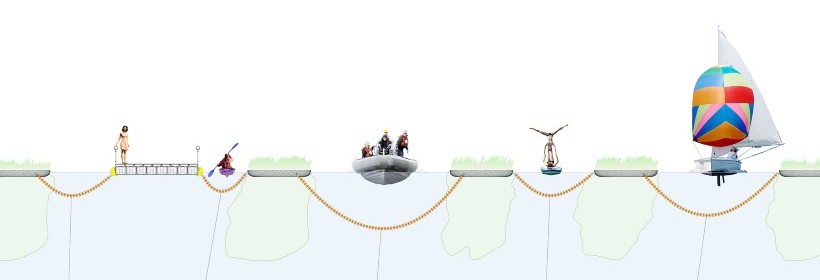Boston’s precarious future
On the east coast of the United States, the city of Boston is considering a 175-mile-long sea wall to protect itself from future storms and rising sea levels.
The city is particularly vulnerable to flooding because of its history of development. Much of Boston’s urban core is located on filled tidelands with surface elevations just barely over today’s flood levels. A 2013 study ranked Boston as the eighth most vulnerable city in terms of overall cost of flood damages of 136 coastal cities studied.
Boston’s precarious future inspired a multi-disciplinary team of 4 to enter the 2018 MIT Climate Changed competition. Could they design a breakwater without having to resort to something as ugly and biologically sterile as a massive concrete wall? The team ended up winning the competition and called their solution The Emerald Tutu, a reference to Boston’s famous network of parks known as the Emerald Necklace.

Across the US, roughly 4.3 million homes concentrated in Florida, California, South Carolina, and Texas, have a substantial risk of sustaining economic damage from flooding this year. According to the First Street Foundation, the national cost of flood damages is expected to rise by nearly 70% over the next 30 years.
With this in mind, Louiza Wise and Gabriel Cira see the Emerald Tutu applied across the nation. “The challenges and adaptation requirements our city faces are fairly ubiquitous across coastal communities. We think that the Emerald Tutu would also be applicable in many of these places.”
A triple win
Emerald Tutu is a network of interconnected floating mats, with marsh grass above the waterline and seaweed below. The network of mats dampens the energy of incoming waves and slows down storm surges, while also soaking up excess stormwater.
A secondary use is recreation: floating pathways running through the artificial marsh offer citizens and visitors access to an extended green waterfront. Thirdly, the mats form a habitat for numerous species and act as a biological filter that improves the water quality.
The team has recently completed testing the mats in the tanks of Oregon State University’s Wave Research Lab as well as finishing field work with a real-world prototype floating in the Boston harbor.

Whether your solution gets implemented is in the end in the hands of a city administration. Is that a big worry for you, that you have to convince all of these people, with all the politics that comes with it?
You are correct that with a municipal customer segment, there is a complex tangle of ownership and stakeholdership that requires working with and gaining approval from many different community constituents. However, we believe we tailor to this complexity by designing our project to be one of community ownership and involvement.
The Emerald Tutu is designed to be low-cost and low in complexity with locally sourced materials meaning that, instead of feeling like they are paying for an advanced, externally-built technology, the community members themselves could be involved in the implementation and maintenance. Through this process of ownership and involvement, the Emerald Tutu becomes a part of the community rather than an imported endeavor.
We also recognize the reality that there is not one single unified solution to coastal flooding, but that we can provide a layer of defense – importantly, one that is situated away from the shore. Due to the existing ownership and use of shorelines, implementing projects that disturb the existing shoreline can become very complex. We avoid this complexity by existing in the nearshore environment.

Are you seeing an appetite among decision makers for nature-based solutions?
We have seen a substantial increase in available funding and completed projects across the country that are targeting not only flood control and mitigation, but using natural and nature-based solutions to do so. For example, in 2020, FEMA (Federal Emergency Management Agency, red.) allocated $737 million in flood control projects.
The Army Corps of Engineers released their first International Guidelines on Natural and Nature-Based Features for Flood Risk Management, and President Biden’s Infrastructure bill has allocated $47 billion for climate resilience planning and projects. And in Massachusetts alone $11.1 million was allocated in 2020 for Climate Mitigation projects through the state’s Municipal Vulnerability Preparedness program, which in the past has funded similar projects including living shorelines.
Are there any other customers for Emerald Tutu besides city councils?
Beyond this significant municipal customer segment, we believe the Emerald Tutu can also be a useful tool for private utilities and commercial/port facilities. This segment is particularly important due to the burden they face of FEMA flood insurance premiums for being in FEMA flooding V zone (at high risk of flood damage).
Many of these developers will implement strategies to reduce their risk and thus change their designation to one with lower insurance premiums.
Examples of these strategies include adding site fill to raise their lowest elevation or building seawalls/berms to provide a barrier against flooding. Similarly, the Emerald Tutu could provide a mediation solution to remove the FEMA V zone designation and lower the risk the private landowner face with their coastal developments.